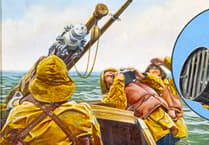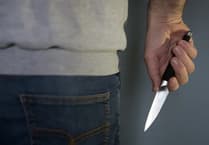AFTER all of the rigorous and extensive safety checks, I was finally ready to take the plunge.
While I had been warned that some people find this claustrophobic or stressful, I found it an amazing feeling – even in a swimming pool – and I would recommend it to anyone.
I had been invited to take part in a Try Dive session with Totnes Sub-Aqua Club at Totnes Pavilions with training officer Mike Balmforth.
I confess, I was a little ahead of the game, having started but never completed my British Sub-Aqua Club Ocean Diver qualification while at university, but it soon became clear that much of what I had learnt I had forgotten after a few years.
Calm, professional and funny, with a pre-occupation with his hair, Mike is a great instructor. He went through all the basic checks and safety points as we put our kit together on the side of the pool. You have your BCD – Buoyancy Control Device – colloquially called a stab vest, which you strap your tank to, then strap to yourself, that can be inflated and deflated to control your ascent or descent; your regulator – the thing in your mouth you breathe with – mask, fins, spare regulator for you or your buddy to use in case of emergency, and your air gauge.
One advantage of training with a BSAC school such as Totnes, is that all the skills are broken down into simple acronyms such as the buddy checks BAR: Buoyancy, Air, Releases – showing your buddy where your kit is, in case of emergency – and 'I do, you copy' teaching, meaning it all becomes second nature.
After the safety checks were out of the way and our hand signals were practiced – remembering that a thumbs up will get you a very different reaction from a diver than anyone else, as it means 'return to surface', and adopting the finger to thumb 'OK' sign instead – its time to get underwater, and even in a swimming pool it is an amazing feeling.
Some people at this moment can feel claustrophobic or panicky, it is, of course, unnatural to be able to breathe underwater, but, as diving officer Ray Harrison said: 'We usually only move in two-dimensions – forwards, backwards, left or right – but underwater you can move in three-dimensions. It's the closest you're likely to get to being weightless, it's a freedom that I love' – it's worth it.'
Mike looked after me closely as we did mask-clearing exercises, making sure I could empty my mask of water without drowning, underwater somersaults, buoyancy control – trying to get the balance right so you could effortlessly hang in the water – and buddy breathing – practising a scenario when my tank stopped working and I had to grab his spare regulator and breathe with that.
One thing that came back to me was the weird feeling of coughing underwater. You're happily tootling along the bottom of the pool and a tiny bit of water creeps in and you think 'I have to cough, I need to be at the surface'.
Coughing through your regulator counter-intuitive but a simple relief, meaning you can continue on enjoying the feeling of being submerged.
Watching someone like Mike and the other group members, they make it look so easy – but they are all so keen for people to enjoy the experience, there is never any pressure. Mike says 'It can take three weeks or three months to get past the swimming pool stage, it doesn't matter, everyone learns at different rates.'
Safeguarding officer Rosemarie Longfield tries to dive every week, and her husband was there at the same time as me, who hadn't dived since 2002.
He called himself a rule of 30 diver: '30 degrees water temperature and 30 meters', which sounded quite sensible to me as the coldest I have ever been in my life was while diving in a quarry in winter.
The couple are off to the Maldives soon and he was re-familiarising himself with the process – so it doesn't matter if you've never dived, you dived years ago and want to refresh your skills, you've moved to the area and want a club to dive interesting places with, or you trained with another dive school and want to cross-over to BSAC, Totnes SAC can do it all with you.
After the dive, Mike took me to the clubb's base at Meadowbrook Community Centre, Dartington, where the team store their two RIBs, their Mitsubishi Shogun for towing them to places such as Salcombe, Thurlestone or Mount Batten, as well as all their kit and the air compressor for filling tanks.
Upstairs, Ray was giving his 'shout', telling members about future dives and training sessions and I watched some videos taken by the team from around our coasts. Visibility in the UK can be low, but when its not, the creatures and marine life you can see is incredible. If you think all the underwater scenery in the UK is brown and a bit boring – you need to see this footage.
Brightly coloured anemones, corals, sea firs, lobsters, more spider crabs than you can count, beautiful fish and playful seals – all right off our own shores – as well as a plethora of shipwrecks to explore.
So, you want to give diving a go, but your not sure whether you'll enjoy it or not – a Try Dive is what you need. Totnes SAC offer CATI – Come And Try It – gift vouchers for just £10. No experience necessary, no commitment to train with Totnes, no need for any equipment – they sort all that out for you – and is open to anyone aged 12-80.
If you wish to continue, they offer the full range on BSAC qualifications: Ocean Diver enables you to dive at depths up to 20m, Sports Diver takes you to 35m; Dive Leader means you can go down to 50m; or you can go on to become an Advanced or First Class Diver.
For more information on Totnes Sub-Aqua Club, visit the website www. totnes-bsac.co.uk, phone Mike on 07862 259694 or email mike@imageworks. plus.com.
The club has CATI sessions at Totnes Pavilions on Wednesdays, January 28 and February 4.




